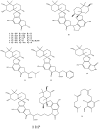Natural Products from Marine Fungi--Still an Underrepresented Resource
- PMID: 26784209
- PMCID: PMC4728516
- DOI: 10.3390/md14010019
Natural Products from Marine Fungi--Still an Underrepresented Resource
Abstract
Marine fungi represent a huge potential for new natural products and an increased number of new metabolites have become known over the past years, while much of the hidden potential still needs to be uncovered. Representative examples of biodiversity studies of marine fungi and of natural products from a diverse selection of marine fungi from the author's lab are highlighting important aspects of this research. If one considers the huge phylogenetic diversity of marine fungi and their almost ubiquitous distribution, and realizes that most of the published work on secondary metabolites of marine fungi has focused on just a few genera, strictly speaking Penicillium, Aspergillus and maybe also Fusarium and Cladosporium, the diversity of marine fungi is not adequately represented in investigations on their secondary metabolites and the less studied species deserve special attention. In addition to results on recently discovered new secondary metabolites of Penicillium species, the diversity of fungi in selected marine habitats is highlighted and examples of groups of secondary metabolites produced by representatives of a variety of different genera and their bioactivities are presented. Special focus is given to the production of groups of derivatives of metabolites by the fungi and to significant differences in biological activities due to small structural changes.
Keywords: Tethya aurantium; biological activities; fungal diversity; marine fungi; marine natural products.
Figures









Similar articles
-
Phylogenetic identification of fungi isolated from the marine sponge Tethya aurantium and identification of their secondary metabolites.Mar Drugs. 2011;9(4):561-585. doi: 10.3390/md9040561. Epub 2011 Apr 6. Mar Drugs. 2011. PMID: 21731550 Free PMC article.
-
Bioactive Secondary Metabolites from a Thai Collection of Soil and Marine-Derived Fungi of the Genera Neosartorya and Aspergillus.Curr Drug Deliv. 2016;13(3):378-88. doi: 10.2174/1567201813666160303104641. Curr Drug Deliv. 2016. PMID: 26935258 Review.
-
Secondary Metabolites from Marine-Derived Fungi from China.Prog Chem Org Nat Prod. 2020;111:81-153. doi: 10.1007/978-3-030-37865-3_2. Prog Chem Org Nat Prod. 2020. PMID: 32114663
-
[New natural products from the marine-derived Aspergillus fungi-A review].Wei Sheng Wu Xue Bao. 2016 Mar 4;56(3):331-62. Wei Sheng Wu Xue Bao. 2016. PMID: 27382779 Review. Chinese.
-
A Review of Terpenes from Marine-Derived Fungi: 2015-2019.Mar Drugs. 2020 Jun 18;18(6):321. doi: 10.3390/md18060321. Mar Drugs. 2020. PMID: 32570903 Free PMC article. Review.
Cited by
-
Cultivable marine fungi from the Arctic Archipelago of Svalbard and their antibacterial activity.Mycology. 2019 Dec 27;11(3):230-242. doi: 10.1080/21501203.2019.1708492. Mycology. 2019. PMID: 33062384 Free PMC article.
-
Enantioselective total synthesis and structural assignment of callyspongiolide.Org Biomol Chem. 2016 Dec 7;14(48):11357-11370. doi: 10.1039/c6ob02051h. Org Biomol Chem. 2016. PMID: 27762414 Free PMC article.
-
Antimicrobial and Antibiofilm Activities of the Fungal Metabolites Isolated from the Marine Endophytes Epicoccum nigrum M13 and Alternaria alternata 13A.Mar Drugs. 2021 Apr 20;19(4):232. doi: 10.3390/md19040232. Mar Drugs. 2021. PMID: 33924262 Free PMC article.
-
Biomaterials from the sea: Future building blocks for biomedical applications.Bioact Mater. 2021 Apr 29;6(12):4255-4285. doi: 10.1016/j.bioactmat.2021.04.028. eCollection 2021 Dec. Bioact Mater. 2021. PMID: 33997505 Free PMC article. Review.
-
Molecular Networking-Based Metabolome and Bioactivity Analyses of Marine-Adapted Fungi Co-cultivated With Phytopathogens.Front Microbiol. 2018 Sep 6;9:2072. doi: 10.3389/fmicb.2018.02072. eCollection 2018. Front Microbiol. 2018. PMID: 30237790 Free PMC article.
References
-
- Lang G., Wiese J., Schmaljohann R., Imhoff J.F. New pentaenes from the sponge-derived marine fungus Penicillium rugulosum: Structure determination and biosynthetic studies. Tetrahedron. 2007;63:11844–11849. doi: 10.1016/j.tet.2007.09.025. - DOI
-
- Paz Z., Komon-Zelazowska M., Druzhinina I.S., Aveskamp M.M., Schnaiderman A., Aluma A., Carmeli S., Ilan M., Yarden O. Diversity and potential antifungal properties of fungi associated with a Mediterranean sponge. Fung. Divers. 2010;42:17–26. doi: 10.1007/s13225-010-0020-x. - DOI
Publication types
MeSH terms
Substances
LinkOut - more resources
Full Text Sources
Other Literature Sources
Medical
Miscellaneous

